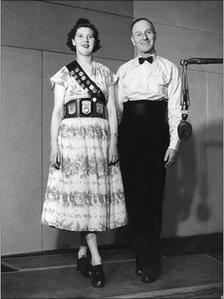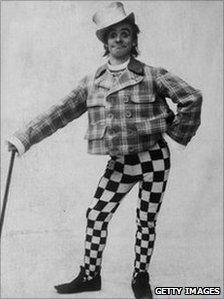Is clog dancing making a comeback?
- Published
Strictly Come Dancing managed to boost the fortunes of ballroom dancing in the UK. Now there are plans to revive a traditional folk dance for the north of England - clog dancing.
When Bruce Forsyth and Tess Daly first unleashed sequin-clad, fake-tanned ballroom dancers back onto our TV screens in 2004, no one predicted how it would change the fortunes of ballroom dancing. The nation fell in love with glitter balls and the ballroom again.

Fast footwork and no sudden movements with the arms
But could traditional British clog dancing be about to follow suit as the next big dance trend?
Conductor and BBC Radio 3 presenter Charles Hazlewood thinks this is the right time to reignite the nation's passion in the clog dance tradition.
He set out to stage the biggest clog dance event ever seen in the UK by surprising the unsuspecting people of Newcastle with flash mob tactics. About 140 people tapped their way through the city centre.
Clog dance has a strong historical tradition in the North East of England, but Hazelwood believes its appeal could go country-wide.
"Clog dancing is a fantastic dance form that we can do in large numbers," he says. "We have so little outlet to do things as a community. When groups of people go to a football match and sing it's an amazing collective experience that can be shared.
"We live in the world of the iPod culture, where music is downloaded and listened to. With clog dance you are physically generating the music yourself."
There was a time during the mid-19th Century when clog dancing was a popular form of family entertainment across much of England.
Although the dance can be traced back to the Middle Ages, the form that exists today took shape during the industrial revolution when clogs were the standard footwear for millions.
Textile and mining communities wore clogs because they were hard-wearing, easy to repair and cheap, costing around three shillings in 1900.
Dances were made up and performed either in the local pub, sometimes on beer barrels, or at home as cheap entertainment.
Laura Connolly, a champion clog dancer who also teaches foot percussion on the folk and traditional music degree course at Newcastle University, would like to see this family tradition revived.
"In the past people didn't have computers or a television, they would roll back the rug in their living room and sing and clog dance to entertain themselves," she says.
Clog dancing was at its peak during the 1880s and 1890s, the heyday of the collieries.
National clog dance competitions were launched, and clog dance challengers, predominantly men, would compete for championship belts. Sometimes competitions lasted several days.
Music hall artists weaved clog dance steps into their acts, which helped take the tradition around the country.
The most famous was Dan Leno, a popular pantomime dame. In 1880 he won the modest title of "World Champion Clog Dancer". The judges, rather dangerously, sat underneath the stage and listened to the beats he made with his feet. Other famous clog dancers included the comedians Stan Laurel and Charlie Chaplin.

Music hall artist Dan Leno was a comedian and champion clog dancer
In 1901 there were more than 6,000 clog makers in England and Wales producing hundreds of thousands of pairs every year, but by the early half of the 20th Century clog dancing was on the decline as tap dancing became a more popular style in the music hall with its radical use of arms.
Trefor Owen, one of the few remaining clog makers in the UK today, believes there was also a stigma attached to clogs.
"One of the things that happened is that around the 1930s, around the big slump... clogs were associated with poverty.
"If you were unemployed in that period, the back end of the workhouse era, you were actually issued clogs if you went in the workhouse. If you were lucky they fitted you, so you've got this sort of stigma."
We still share a sense of embarrassment today about the dance, says Ms Connolly, who has been clog dancing for 16 years.
"In other countries their culture is singing and dancing and that is natural to them, and it seems in our country we shy away from it.
"I'd like people not to feel embarrassed by it. When I started learning at the age of 13 I had to keep it a secret. I wasn't going to tell anyone I was a clog dancer."

Clogs became a symbol of poverty and destitution in the early twentieth century
Small groups of folk dance revivalists have kept the tradition alive in the twenty-first century and the popularity of clog dancing is on the increase, according to Jo Breeze of the English Folk Dance and Song Society.
"We are seeing a real rise in interest in folk traditions of all sorts - dance, music, ritual. There's a huge surge of interest in cultural and creative activities that people can take part in, not just be passive consumers.
"Clog dancing, morris dancing, ceilidhs, social dance - they're all ways that people are finding to connect with the traditions of the British Isles and make them relevant for themselves."
Contemporary choreographers have begun to notice the visual similarities between folk dance and more current styles such as street dance. Live music and dance acts, such as the Demon Barber Roadshow, have begun to bring together clog and morris dance with break-dancing, popping and krumping.
So maybe it is time to roll back the living room rug and join in.
Come Clog Dancing: Treasures of English Folk Dance will be broadcast on BBC Four at 1900 GMT on Saturday 11 December, or catch up on BBC iPlayer